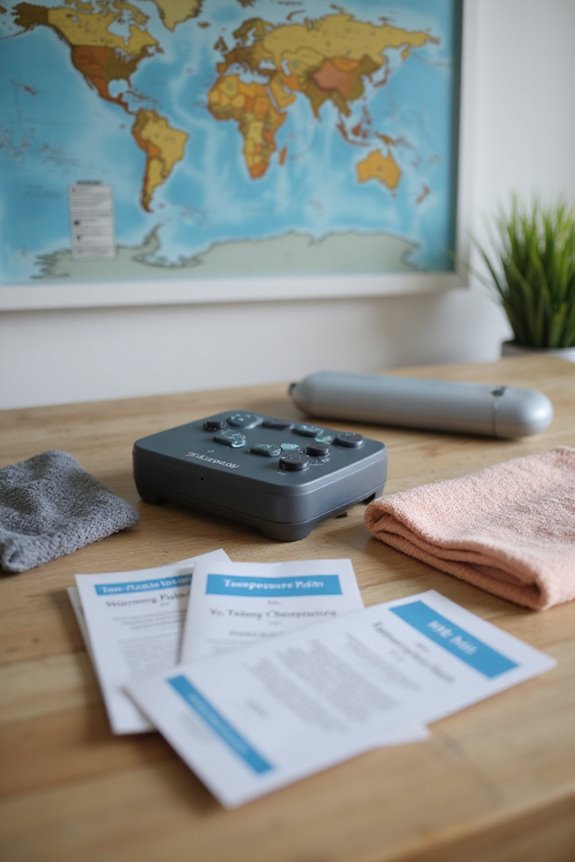Pain management programs measure success through various metrics that guarantee effective treatment. Key performance indicators include pain intensity reduction, assessed via scales like VAS and NRS, and functional capabilities tracked by the Oswestry Disability Index. Patient satisfaction rates often exceed 85%, enhancing retention. Treatment success rates vary, with physiotherapy achieving 80%. Cost efficiency analysis monitors operational expenses, while long-term outcomes guarantee sustainability. Further insights reveal additional methods and tools used to enhance these programs.
Key Takeaways
- Pain intensity is measured using patient-reported scores, targeting a 15-20% improvement through standardized scales like VAS and NRS.
- Functional capabilities are assessed through tools like the Oswestry Disability Index, evaluating mobility and endurance post-treatment.
- Patient satisfaction is gauged using the APainCQ tool, with high satisfaction rates correlating to retention exceeding 85%.
- Treatment success rates are calculated based on the percentage of patients reporting significant pain relief from various therapies.
- Long-term monitoring of outcomes ensures sustainability of treatment benefits and informs adjustments to pain management strategies.
Key Performance Indicators for Pain Reduction
Measuring the effectiveness of pain management programs necessitates the establishment of key performance indicators (KPIs) that focus on pain reduction. Primary metrics include:
- Pain Intensity: Tracking patient-reported pain intensity scores over time, aiming for a typical 15-20% improvement. Standardized scales like the Visual Analog Scale (VAS) or Numeric Rating Scale (NRS) guarantee consistency.
- Functional Capabilities: Evaluating enhancements in daily functioning through tools such as the Oswestry Disability Index. Monitoring return-to-work rates and changes in mobility, range of motion, and endurance offers insight into overall success.
- Sustainability: Evaluating long-term pain relief post-treatment enhances understanding of program effectiveness. This data-driven approach facilitates optimization of therapeutic strategies, ultimately improving patient outcomes and quality of life.
Patient Satisfaction and Retention Metrics

Patient satisfaction and retention metrics play a pivotal role in evaluating the success of pain management programs. High satisfaction rates, often exceeding 85%, correlate with improved patient retention. Key tools, such as the APainCQ, assess satisfaction across various dimensions, including pain relief and healthcare team interactions.
- Patient feedback gathered through surveys helps identify areas needing improvement.
- Engagement strategies that involve patients in care decisions enhance their commitment to treatment.
- Numeric rating systems indicate average satisfaction levels, typically around 7.1 out of 10.
Utilization and Effectiveness of Technology

The utilization of technology in pain management has transformed treatment approaches, leading to enhanced patient outcomes and improved efficiency in care delivery. Key components include:
- Technology Integration: Devices like Peripheral Nerve Stimulation (PNS) and mobile apps facilitate continuous pain tracking and medication adherence, fostering patient engagement.
- Data Analysis: AI algorithms analyze large datasets to personalize treatment, predict patient responses, and enhance pain assessment accuracy.
- Telemedicine: Remote monitoring expands access, allowing efficient follow-ups and maintaining continuity of care.
- Patient Acceptance: Acceptance of eHealth interventions is influenced by factors such as age and digital literacy, impacting utilization rates.
Incorporating these technologies guarantees that pain management strategies are responsive, tailored, and effective, ultimately benefiting patients and healthcare providers alike.
Treatment Success Rate Evaluations

Evaluating treatment success rates is fundamental in appraising the effectiveness of pain management interventions.
- Treatment success rates are calculated as the percentage of patients reporting significant and sustained pain relief.
- Individual therapies, such as acupuncture (70%), chiropractic care (75%), physiotherapy (80%), and integrated therapies (up to 85%), are evaluated through treatment modalities comparison.
- Patient-reported outcomes, including feedback from surveys, enhance the understanding of perceived pain relief and quality of life.
- Success rate analysis supports informed decision-making, enabling clinics to refine treatment plans based on patient satisfaction and engagement.
- Long-term monitoring is essential for confirming the sustainability of treatment benefits, distinguishing between transient improvements and genuine success.
This structured approach guarantees ideal patient outcomes in pain management programs.
Quality Measures and Clinical Performance

Quality measures and clinical performance are critical components in evaluating the effectiveness of pain management programs. Key elements include:
- Standardized pain assessment tools for consistent documentation.
- Patient-reported outcome measures (PROMs) to gauge intervention effectiveness.
- Completion of pain assessments at each eligible visit to guarantee adherence to processes.
Moreover, monitoring provider communication skills enhances patient engagement, while baseline and periodic functional outcome tracking assists in measuring clinical progress.
Integrating electronic health records streamlines data collection and reporting, guaranteeing accuracy.
Regular benchmarking against national standards supports ongoing quality improvement initiatives, identifying strengths and areas for enhancement.
Collectively, these measures foster a culture of accountability and continuous improvement in pain management practices, ultimately benefiting patient outcomes and care quality.
Cost Efficiency and Resource Utilization
Cost efficiency and resource utilization play essential roles in the overall success of pain management programs. Effective cost allocation is critical for optimizing expenditures and maximizing outcomes.
- Staff Salaries and Benefits: 40% to 50% of total costs.
- Facility Expenses: 15% to 20% of operational costs.
- Healthcare Technology: Initial investments range from $20,000 to $50,000.
- Marketing: Consumes about 10% to 15% of the budget.
- Consumable Supplies: Costs fluctuate based on patient volume.
Budget analysis focuses on:
- Revenue per Patient Visit: Monitored for financial health.
- Staff Utilization Rate: Average of 80%.
- Patient Retention Rate: Approximately 75%.
These metrics guarantee effective resource utilization while enhancing program sustainability and financial stability.
Long-term Sustainability of Pain Relief
How can pain management programs guarantee long-term sustainability in pain relief?
- Evidence from longitudinal studies indicates that interdisciplinary pain management programs yield significant improvements in pain severity and functional interference, maintaining benefits for most outcomes up to one year post-treatment.
- Integrated therapy, which combines various modalities including physical and cognitive behavioral therapies, targets multiple domains of chronic pain more effectively than single-modality treatments.
- While emotional distress improvements may not persist long-term, metrics such as patient perceived control over pain remain stable.
- Nonpharmacologic interventions contribute to sustained pain relief and reduction in opioid dependence.
- Overall, integrated programs show durable improvements, emphasizing the importance of a holistic approach for long-term success in pain management.
Frequently Asked Questions
What Types of Therapies Are Included in Pain Management Programs?
Pain management programs typically include diverse therapy types, such as physical therapy to enhance mobility and relieve pain, alongside various medication options like analgesics and topical treatments, fostering a thorough approach to pain relief and recovery.
How Often Should Patients Expect Follow-Up Assessments?
In the garden of healing, follow-up assessments bloom at intervals dictated by frequency guidelines; 1 to 4 weeks for initial therapies. Assessment methods evolve, nurturing growth and understanding, fostering a shared journey toward pain relief and well-being.
Are There Any Risks Associated With Pain Management Therapies?
Pain management therapies carry inherent risks, including side effects like respiratory depression and nausea, along with treatment complications such as inadequate relief or potential addiction. Understanding these challenges fosters a supportive environment for effective pain management.
Can Lifestyle Changes Impact the Success of Pain Management?
Lifestyle modifications profoundly influence chronic pain management, akin to a symphony harmonizing diverse instruments. By embracing exercise, nutrition, and stress reduction, individuals foster resilience, ultimately enhancing their capacity to navigate pain and cultivate a sense of belonging.
What Role Do Healthcare Providers Play in Pain Management Programs?
Healthcare providers play a vital role in pain management programs through effective provider communication and treatment collaboration. Their teamwork fosters thorough care, ensuring tailored interventions that address both physical and emotional aspects of pain for best patient outcomes.





